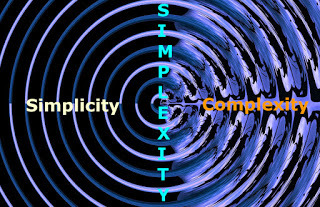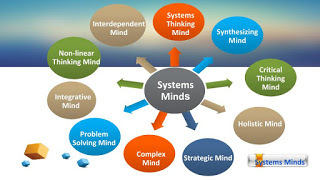Pearl Zhu's Blog, page 1293
September 27, 2016
Grease the Wheel of IT to Accelerate Digital Transformation
 In the industrial age, traditional IT was running as an isolated support function with friction. At the dawn of the Digital Era, with increasing speed of changes, IT needs to be reinvented to achieve its own potential and help the business maximize the performance. How to grease the wheel of IT to accelerate digital transformation.
In the industrial age, traditional IT was running as an isolated support function with friction. At the dawn of the Digital Era, with increasing speed of changes, IT needs to be reinvented to achieve its own potential and help the business maximize the performance. How to grease the wheel of IT to accelerate digital transformation.
Streamline information flow across functional boundaries: Information and technology catalyze today's digital businesses. Information brings about business ideas or insight; business ideas generate lots of information. Information comes from the analysis of that data, technology allows for the storage, capture, manipulation, and presentation of data. Information Systems are the backbone and provide valuable information for key decision making. In the organization with a lower level of maturity, the business is struggling with overly restrictive hierarchy and bureaucratic mentality, the silo walls and infighting are all the cause of business frictions. Even IT organization is usually the data steward of the organization, it still has to overcome the functional barriers or office politics to keep information flow and manage data lifecycle effectively. It is so critical to streamline information flow across functional boundaries, because fundamentally, Information Management is to make sure that the right information is at the right place at the right time and shared to the right persons.
Optimize business processes to keep ideas flow and implemented: Business frictions often stifle innovation and decrease organizational efficiency and productivity. Digital catalyzes the culture of innovation due to the convenience of learning and sharing. How these ideas are recognized, filtered and dealt with well become a crucial factor in an organization's success in producing digitized products and services. Traditional IT organizations have a controller’s mentality and sometimes lag behind the changes, as the result, the gaps between IT and business are enlarged, and the digital transformation is decelerated. To reinvent IT as an innovation engine means, IT needs to keep optimizing business processes, and reframing of business planning in order, build the appropriately configured innovation platform with scalability for sharing and building ideas throughout the enterprise. As a result, innovation becomes a persistent, shared reality, even across silos and geographies. A well-considered tool/platform for innovation, in the given culture, operating environment, and governance could strengthen the innovation effort and success rate to the organization.
 Grease the wheel of IT for the automation and delivery of product and service: Developing and delivering tools down to departments and users help those better do their job, is one of the most critical roles for IT. Automation is needed for efficiency to balance the demand and supply. The first stage in the journey to automation must be to examine every process and identify how it can be made more efficiently and how it connects to other processes, in order to run more streamlined and profitable operations. Many IT departments operate in silos with separate teams delivering separate functional task. Effective automation should first examine these functions and understand the connections and define any constraints in the system. Identify and remove the inefficiencies and rationalize the manual actions first. As this process goes along, see what can be automated by using the automation available natively within many of the tools you already have, but don’t use it because you don’t examine the processes from a holistic viewpoint on a regular basis.
Grease the wheel of IT for the automation and delivery of product and service: Developing and delivering tools down to departments and users help those better do their job, is one of the most critical roles for IT. Automation is needed for efficiency to balance the demand and supply. The first stage in the journey to automation must be to examine every process and identify how it can be made more efficiently and how it connects to other processes, in order to run more streamlined and profitable operations. Many IT departments operate in silos with separate teams delivering separate functional task. Effective automation should first examine these functions and understand the connections and define any constraints in the system. Identify and remove the inefficiencies and rationalize the manual actions first. As this process goes along, see what can be automated by using the automation available natively within many of the tools you already have, but don’t use it because you don’t examine the processes from a holistic viewpoint on a regular basis.
The Role of IT today for many organizations is a business solutionary for information, automation, and innovation. Although the real goal is, as is the case with every part of the organization, helping the business become, stay, and increase profitability! The wheel of IT in the current business environment should be able to keep spinning to enabling business outcomes and accelerate digital transformation.
Follow us at: @Pearl_Zhu
Published on September 27, 2016 22:51
September 26, 2016
The Monthly “Dot Connections” Vision vs. Leadership Sep. 2016
Digital is the age of creativity and innovation, and creativity is all about connecting the dots.
 The effects of an increasingly digitalized world are now reaching into every corner of businesses and every aspect of organizations. Digital is the age of creativity and innovation, creativity is the most wanted trait for digital leaders and professionals today, and innovation is the light every organization is pursuing. Creativity is all about connecting the dots. Which dots shall you connect between vision and leadership in order to accelerate digital transformation?
The effects of an increasingly digitalized world are now reaching into every corner of businesses and every aspect of organizations. Digital is the age of creativity and innovation, creativity is the most wanted trait for digital leaders and professionals today, and innovation is the light every organization is pursuing. Creativity is all about connecting the dots. Which dots shall you connect between vision and leadership in order to accelerate digital transformation?
Vision vs. Leadership Sep. 2016
Vision vs. Strategy: Vision is where or who you want to be and strategy is how you can achieve or reach your goal. An unclear vision leads to defective strategy. Visions inspire; strategies compel; vision comes first, but sometimes vision appears and gets clear by working on the strategy. A vision describes the desired future position of the company. A strategy is an action or ways chosen to bring about the desired future, such as achievement of a goal.?Vision vs. Insight? As businesses and the world move deeper and deeper into the digital world of VUCA -volatility, uncertainty, complexity, and ambiguity, one of the most desired traits for leaders is VISION, because leadership is all about direction, it shows people where to go; and the other equally important leadership trait is INSIGHT, because it brings up the big WHY - why do you go where you are going and how to get there. So more specifically, what are apple to apple comparisons between vision vs. insight? The Future-Driven Leadership - Vision vs. Leadership The substance of leadership never changes. It’s all about making the positive influence, and providing direction, both for oneself and others. Leadership is about CHANGE. It is a basic human ability to inspire self and others to look beyond limitations and make continuous improvement. This ability becomes a capability if we constantly nurture our basic human instincts of HUMILITY, CURIOSITY, and CREATIVITY. Fundamentally, leadership is more about future but starts at today.Is Digital Leadership all about Vision - Vision vs. Digital Leadership? As businesses and the world move deeper and deeper into the digital world of VUCA -volatility, uncertainty, complexity, and ambiguity, leaders of any organization, large or small, must capture the foresight of digitalization, gain the insight upon globalization, and become knowledgeable about the terrain of the hyper-connected land out there. More specifically, leaders need to have a clear vision to zoom into the future and broadened knowledge to zoom out the reality, in order to guide the business through the digital transformation. However, is digital leadership all about vision?. Leadership vs Vision: Leadership is about the future, leadership vision is not just about zooming in, but also stepping into the future, to bridge the gap between today and tomorrow; local and global, industrial age and digital era, the mind and the behavior. More specifically, what is leadership vision, do you have one?The “Future of CIO” Blog has reached 1.5 million page views with about #3100th blog posting in 59+ different categories of leadership, management, strategy, digitalization, change/talent, etc. The content richness is not for its own sake, but to convey the vision and share the wisdom. Blogging is not about writing, but about thinking and innovating the new ideas; it’s not just about WHAT to say, but about WHY to say, and HOW to say it. It reflects the color and shade of your thought patterns, and it indicates the peaks and curves of your thinking waves. Unlike pure entertainment, quality and professional content takes time for digesting, contemplation and engaging, and therefore, it takes the time to attract the "hungry minds" and the "deep souls." It’s the journey to amplify diverse voices and deepen digital footprints, and it's the way to harness your innovative spirit.
Leadership vs Vision: Leadership is about the future, leadership vision is not just about zooming in, but also stepping into the future, to bridge the gap between today and tomorrow; local and global, industrial age and digital era, the mind and the behavior. More specifically, what is leadership vision, do you have one?The “Future of CIO” Blog has reached 1.5 million page views with about #3100th blog posting in 59+ different categories of leadership, management, strategy, digitalization, change/talent, etc. The content richness is not for its own sake, but to convey the vision and share the wisdom. Blogging is not about writing, but about thinking and innovating the new ideas; it’s not just about WHAT to say, but about WHY to say, and HOW to say it. It reflects the color and shade of your thought patterns, and it indicates the peaks and curves of your thinking waves. Unlike pure entertainment, quality and professional content takes time for digesting, contemplation and engaging, and therefore, it takes the time to attract the "hungry minds" and the "deep souls." It’s the journey to amplify diverse voices and deepen digital footprints, and it's the way to harness your innovative spirit.
Follow us at: @Pearl_Zhu
 The effects of an increasingly digitalized world are now reaching into every corner of businesses and every aspect of organizations. Digital is the age of creativity and innovation, creativity is the most wanted trait for digital leaders and professionals today, and innovation is the light every organization is pursuing. Creativity is all about connecting the dots. Which dots shall you connect between vision and leadership in order to accelerate digital transformation?
The effects of an increasingly digitalized world are now reaching into every corner of businesses and every aspect of organizations. Digital is the age of creativity and innovation, creativity is the most wanted trait for digital leaders and professionals today, and innovation is the light every organization is pursuing. Creativity is all about connecting the dots. Which dots shall you connect between vision and leadership in order to accelerate digital transformation?
Vision vs. Leadership Sep. 2016
Vision vs. Strategy: Vision is where or who you want to be and strategy is how you can achieve or reach your goal. An unclear vision leads to defective strategy. Visions inspire; strategies compel; vision comes first, but sometimes vision appears and gets clear by working on the strategy. A vision describes the desired future position of the company. A strategy is an action or ways chosen to bring about the desired future, such as achievement of a goal.?Vision vs. Insight? As businesses and the world move deeper and deeper into the digital world of VUCA -volatility, uncertainty, complexity, and ambiguity, one of the most desired traits for leaders is VISION, because leadership is all about direction, it shows people where to go; and the other equally important leadership trait is INSIGHT, because it brings up the big WHY - why do you go where you are going and how to get there. So more specifically, what are apple to apple comparisons between vision vs. insight? The Future-Driven Leadership - Vision vs. Leadership The substance of leadership never changes. It’s all about making the positive influence, and providing direction, both for oneself and others. Leadership is about CHANGE. It is a basic human ability to inspire self and others to look beyond limitations and make continuous improvement. This ability becomes a capability if we constantly nurture our basic human instincts of HUMILITY, CURIOSITY, and CREATIVITY. Fundamentally, leadership is more about future but starts at today.Is Digital Leadership all about Vision - Vision vs. Digital Leadership? As businesses and the world move deeper and deeper into the digital world of VUCA -volatility, uncertainty, complexity, and ambiguity, leaders of any organization, large or small, must capture the foresight of digitalization, gain the insight upon globalization, and become knowledgeable about the terrain of the hyper-connected land out there. More specifically, leaders need to have a clear vision to zoom into the future and broadened knowledge to zoom out the reality, in order to guide the business through the digital transformation. However, is digital leadership all about vision?.
 Leadership vs Vision: Leadership is about the future, leadership vision is not just about zooming in, but also stepping into the future, to bridge the gap between today and tomorrow; local and global, industrial age and digital era, the mind and the behavior. More specifically, what is leadership vision, do you have one?The “Future of CIO” Blog has reached 1.5 million page views with about #3100th blog posting in 59+ different categories of leadership, management, strategy, digitalization, change/talent, etc. The content richness is not for its own sake, but to convey the vision and share the wisdom. Blogging is not about writing, but about thinking and innovating the new ideas; it’s not just about WHAT to say, but about WHY to say, and HOW to say it. It reflects the color and shade of your thought patterns, and it indicates the peaks and curves of your thinking waves. Unlike pure entertainment, quality and professional content takes time for digesting, contemplation and engaging, and therefore, it takes the time to attract the "hungry minds" and the "deep souls." It’s the journey to amplify diverse voices and deepen digital footprints, and it's the way to harness your innovative spirit.
Leadership vs Vision: Leadership is about the future, leadership vision is not just about zooming in, but also stepping into the future, to bridge the gap between today and tomorrow; local and global, industrial age and digital era, the mind and the behavior. More specifically, what is leadership vision, do you have one?The “Future of CIO” Blog has reached 1.5 million page views with about #3100th blog posting in 59+ different categories of leadership, management, strategy, digitalization, change/talent, etc. The content richness is not for its own sake, but to convey the vision and share the wisdom. Blogging is not about writing, but about thinking and innovating the new ideas; it’s not just about WHAT to say, but about WHY to say, and HOW to say it. It reflects the color and shade of your thought patterns, and it indicates the peaks and curves of your thinking waves. Unlike pure entertainment, quality and professional content takes time for digesting, contemplation and engaging, and therefore, it takes the time to attract the "hungry minds" and the "deep souls." It’s the journey to amplify diverse voices and deepen digital footprints, and it's the way to harness your innovative spirit.Follow us at: @Pearl_Zhu
Published on September 26, 2016 22:53
The New Book “Thinkingaire” Chapter Four Agile Minds Introduction
 In a broader scope, “agility” is a philosophy of managing complexity and unpredictability through empiricism. Agility is the ability to adapt to the changes. Agile minds see the world via three “I”s Interaction, Improvement, and innovation. Agile is a state of mind based on a set of principles, via understanding that in order for Agile to work, it needs to be cultural, not an imposed afterthought. Ultimately, all aspects of the enterprise from strategic planning to the most atomic levels task much embrace agile philosophy for optimal effect:
In a broader scope, “agility” is a philosophy of managing complexity and unpredictability through empiricism. Agility is the ability to adapt to the changes. Agile minds see the world via three “I”s Interaction, Improvement, and innovation. Agile is a state of mind based on a set of principles, via understanding that in order for Agile to work, it needs to be cultural, not an imposed afterthought. Ultimately, all aspects of the enterprise from strategic planning to the most atomic levels task much embrace agile philosophy for optimal effect:
A Customer-Centric Mind: The digital business ecosystem is still evolving. The digital dynamic continues to evolve with increasing speed of change and rapid integration of business across the globe. How to become a customer-centric business is in every forward-looking organization’s agenda, it requires not just management, but every digital professional to shape a customer-centric mind, think through the lens of customers’ viewpoint, outside-in. There is nothing wrong with looking at the customer experience from the inside out. Because you are the one that can change the inside. However, the outside-in view is more important, because the customer’s experience is about how they encounter, observe or undergo a company’s events or stages. You lay out a journey which is a helpful, positive, and sharing experience with your customers. You need to operate from the realization that the customer is the lifeline of the business. Once you have this basic premise right, everything flows naturally and exceptional customer service and WOW moments will be the automatic result.
An Accelerated Mind: With increasing speed of changes, the mind also needs to be shifted and accelerated from the fixed mind to an accelerated mind. Fix mind refers to those who approach their work with fixed mindset, the assumption that their abilities are innate and not subject to changes, while an accelerated mind refers to those who solve problems or target the goals with a growth mindset - the belief that their ability level is nothing more than a snapshot in time and eminently changeable as they continue to learn and develop. A growth mind is a strategic imperative to adapt to the changes and an accelerated mind is needed to match the digital speed. Furthermore, to speed up and accelerate digital transformation, companies should capture their collective insight, which is more connected and accelerated than any single mindset, and analyze all critical, cross functional processes, to connect divergent factors for the business ecosystem in decision making and business strategic planning.
 A Learning Mind: In today’s fierce knowledge, technology, and innovation economy, change is the new normal, and the speed of change is increasing. Learning is the way to keep your mind flowing, and hence your life flowing, because when you stop learning, you are stagnant. At the individual level, being a continuous learner is no longer simply a choice we can make. It is a necessity and imperative if we expect to add value, to compete for the future with authenticity and consistency. At the organizational level, the hyperconnected global workplace opens up a whole new world on how to build a creative and productive workforce, or put simply, how to build a learning customer- grooming the collective learning mind to encourage both employees and an organization as a whole to grow.
A Learning Mind: In today’s fierce knowledge, technology, and innovation economy, change is the new normal, and the speed of change is increasing. Learning is the way to keep your mind flowing, and hence your life flowing, because when you stop learning, you are stagnant. At the individual level, being a continuous learner is no longer simply a choice we can make. It is a necessity and imperative if we expect to add value, to compete for the future with authenticity and consistency. At the organizational level, the hyperconnected global workplace opens up a whole new world on how to build a creative and productive workforce, or put simply, how to build a learning customer- grooming the collective learning mind to encourage both employees and an organization as a whole to grow. Digital thinking makes significant impacts on every aspect of the business from people, process, to technology, both horizontally and vertically. People are always the weakest link in any change or transformation effort. The way to change the game is to change the mindset, to adapt to change, and to move the world forward.Follow us at: @Pearl_Zhu
Published on September 26, 2016 22:47
“Thinkingaire Effect” in IT Transformation: Reboot IT Mindset
 IT plays a significant role in digital transformation. IT transformation is an integral part of the business transformation: There are changes in two shapes: One is internal where IT transforms and the second where IT helps transform or change the business in line with new strategic imperatives. Transformation is the radical change, it needs to reboot IT mindset before it can change its attitude, and build the set of capabilities to drive digital transformation.
IT plays a significant role in digital transformation. IT transformation is an integral part of the business transformation: There are changes in two shapes: One is internal where IT transforms and the second where IT helps transform or change the business in line with new strategic imperatives. Transformation is the radical change, it needs to reboot IT mindset before it can change its attitude, and build the set of capabilities to drive digital transformation.
Leadership mindset: Traditional IT leaders often act as tactical technology manager to manage IT from operation lens, they often don’t have enough hands-on business expertise. Unfortunately, too many CIOs are seen as just techies by the business side of the house, hence, many IT organizations are still perceived as a support center to keep the lights on, far away from the transformational role IT is supposed to play. Hence, in order to be an effective Digital CIO, you must understand every aspect of the business. Digital CIOs need to be equipped with the intrapreneurs' mindset to focus on both top-line business growth and bottom line efficiency. It is not something that is done by the tired cliché of leading by example, but in creating that compelling vision, differentiated competency, that ability to enable others to succeed, that gets you to the top, not on the backs of others, but carried on their shoulders in triumph. Only through leadership mind shift, IT can reinvent itself as a digital growth engine.
Reboot IT mindset from a service provider to the Strategic Partner: IT is not just a service provider but is attempting to become that business partner, then a trusted advisor and business peer, and even a trusted digital transformer. IT has the history and tradition of being a very expensive cost center, often with the little demonstrable value that typically misses its commitments. To improve maturity, IT organizations need to be assertive in preparing and engaging effectively and efficiently with their business partners in these strategic initiatives. IT customers (the business units) are looking for strategic business partners that have the oversight of all the business processes due to the system and landscape knowledge IT have maintained over the years. With the digital mind shift, good operational knowledge of the entire business combined with advanced systems and business architectural knowledge. The more intimate IT can be with the business needs, the faster IT can move up to a business partner, then business peer. IT will not "be the business" if it does not focus on the top prioritized business initiatives.
 Reboot IT to bridge business-IT gaps via effective communication: One of the large barriers to stop IT and the business as a whole from reaching high maturity is the gaps between IT and business. Harness communication by exploring the root causes of business-IT gaps and ineffective management. One of the major sources of the divide that segregates business and IT is the communications dialog - the lexicon used to communicate between people. Part of the situation is that the types of services the IT group is providing is being defined a priori and hence limiting the directions you can take it. What C-level execs really want is a partner, someone who knows what they want before they know themselves, who innovates by understanding the business, as well as what they do; the partner that works both "on the business" and "in the business," not just "for the Business." The best way to advocate IT is to reboot IT mindset, to communicate more proactively with critical thinking and creative mind, the clear message from IT is to have business buy-in, grow IT as change/innovation engine, and IT need to communicate the new perspective effectively in order for the organization as a whole to move forward.
Reboot IT to bridge business-IT gaps via effective communication: One of the large barriers to stop IT and the business as a whole from reaching high maturity is the gaps between IT and business. Harness communication by exploring the root causes of business-IT gaps and ineffective management. One of the major sources of the divide that segregates business and IT is the communications dialog - the lexicon used to communicate between people. Part of the situation is that the types of services the IT group is providing is being defined a priori and hence limiting the directions you can take it. What C-level execs really want is a partner, someone who knows what they want before they know themselves, who innovates by understanding the business, as well as what they do; the partner that works both "on the business" and "in the business," not just "for the Business." The best way to advocate IT is to reboot IT mindset, to communicate more proactively with critical thinking and creative mind, the clear message from IT is to have business buy-in, grow IT as change/innovation engine, and IT need to communicate the new perspective effectively in order for the organization as a whole to move forward.
CIOs have to deal with constant ambiguity, increasing complexity, rapid change, and unprecedented uncertainty, either IT transformation or the organization’s overall digital transformation is a journey. Rebooting IT is not just about making IT look good, but in making the business players be everything possible with your help, and unleash the digital potential of the organization. CIOs need to be prepared to invest in the future, they cannot ignore the benefits of properly leveraging what already exists.The goal in IT transformation should be focused on business outcomes, and running IT as a business.
Follow us at: @Pearl_Zhu
Published on September 26, 2016 22:43
September 25, 2016
CIOs as Change Agent: Three Focal Point in Change Management
 Business Change Management is managing everything that is necessary to get people to adopt new ways of working such as stakeholder management, communications, process or organizational change, business readiness or technical change management, etc. More than two thirds of Change Management effort fails to achieve the expectation. How to get ahead of change curves, what are the focal point to frame the right problems to solve, make change tangible rather than fluffy?
Business Change Management is managing everything that is necessary to get people to adopt new ways of working such as stakeholder management, communications, process or organizational change, business readiness or technical change management, etc. More than two thirds of Change Management effort fails to achieve the expectation. How to get ahead of change curves, what are the focal point to frame the right problems to solve, make change tangible rather than fluffy?
Discover the root cause of issues, or the big WHY about changes: Compared to the business world a couple of decades ago, the speed of change is increasing, and digital ecosystem has become more complex and dynamic. To put simply, change itself changes. Therefore, don't just rush up to follow the best practice for Change Management, but invest enough time to discover the root cause of issues. Digging through the big WHY is extremely important either for change or any kind of business initiatives, and leveraging Systems Thinking to discover the root cause is about seeing the interconnectivity between the parts and the whole. All changes requires a cooling period. Businesses can not take change initiatives for granted.
Setting the priority right: Change Management often won’t go alone, it should go hand in hand with Strategy Management, Program Management, or Performance Management. Priority should be clear, approved and shared, the staff should know the big pictures, and know what their role is in it. Ensure people committed and incentivized to the plan/priorities or agree on an exit. More specific steps in managing change and setting right priorities include: (a) Keep it simple, not simpler. (b) Accomplish change by identifying the pain points through unique well-developed processes. © Outline the implementation process with assignments, timelines, and deliverable. (d) Remove cultural, organizational or systemic obstacles. ..
 Measurements are in place: First ensure the right things and measure them in the right way. The challenge with measuring change has something to do with the complexities of the organization that is imposing change on their employees. How can you design the good metrics to measure what changes and how those changes are measured. What are the relevant metrics and how can they be quantified and validated. The ineffective measurement can cause more problems and encourage silo thinks. For example, When only individual or departmental outcomes are measured, the silo walls go up. Differentiated performance metrics and rewards systems tend to influence people’s behaviors, hence, they need to be adjusted to fit the ultimate business goals. Measuring change involves first accurately identifying where you are now, and then clearly identifying where you want to be once the change is complete. Keep change elegant and measurable. Change Management has a very wide scope and is a relatively new area of expertise, it needs to focus on coordination and facilitation, follow the right set of principles and take the best or next practices. The speed of change is increasing, therefore, the change capability needs to be cultivated, not for its own sake, but for improving organizational effectiveness and agility.Follow us at: @Pearl_Zhu
Measurements are in place: First ensure the right things and measure them in the right way. The challenge with measuring change has something to do with the complexities of the organization that is imposing change on their employees. How can you design the good metrics to measure what changes and how those changes are measured. What are the relevant metrics and how can they be quantified and validated. The ineffective measurement can cause more problems and encourage silo thinks. For example, When only individual or departmental outcomes are measured, the silo walls go up. Differentiated performance metrics and rewards systems tend to influence people’s behaviors, hence, they need to be adjusted to fit the ultimate business goals. Measuring change involves first accurately identifying where you are now, and then clearly identifying where you want to be once the change is complete. Keep change elegant and measurable. Change Management has a very wide scope and is a relatively new area of expertise, it needs to focus on coordination and facilitation, follow the right set of principles and take the best or next practices. The speed of change is increasing, therefore, the change capability needs to be cultivated, not for its own sake, but for improving organizational effectiveness and agility.Follow us at: @Pearl_Zhu
Published on September 25, 2016 22:50
The New Book “Thinkingare” Chapter 3 Introduction: Hybrid Minds
 We live in the digital world with all sorts of hybrid solutions. Organizations today are not limited to the physical buildings, but well mixed with virtual collaboration. Social business is perceived as the future of organization within the hybrid, networked, and extended modern working environment to empower workforce sharing thoughts and ideas, to engage customers and partners voicing their concerns and feedback, and to encourage broader conversations and interactions with the business ecosystem. Hybrid Thinking is a set of interdisciplinary and integrative thinking processes we will need to solve many of today’s complex problems which require strategic consideration, systems intelligence, innovative approaches, cross-cultural and cross-generational perspectives.
We live in the digital world with all sorts of hybrid solutions. Organizations today are not limited to the physical buildings, but well mixed with virtual collaboration. Social business is perceived as the future of organization within the hybrid, networked, and extended modern working environment to empower workforce sharing thoughts and ideas, to engage customers and partners voicing their concerns and feedback, and to encourage broader conversations and interactions with the business ecosystem. Hybrid Thinking is a set of interdisciplinary and integrative thinking processes we will need to solve many of today’s complex problems which require strategic consideration, systems intelligence, innovative approaches, cross-cultural and cross-generational perspectives.
Agile Critical Thinking: The Digital Era is the hybrid era: the physical world is blurring with virtual world, the work life is blurring with personal life, and the hard disciplines such as science and engineering are blurring with soft disciplines such as art and philosophy, etc., the “STEM” extends to “STEAM.” Hybrid Thinking can combine different thinking patterns in order to analyze and synthesize for effective problem-solving. How about Agile Thinking meeting with Critical Thinking? Agile Thinking can apply to creative, strategic, self-reflective or collective thought processes, etc. Critical Thinking helps to recognize that logic and reason alone are not enough, and maintain low ceilings. If logic and reason were the keys, all problems would have been solved a long time ago. “Agile Critical Thinking” approach is to teach people how to apply Critical Thinking techniques to evaluate and incorporate data about individual differences, team dynamics, and organizational realities into equation rather than dismiss or minimize their impact.
A Simplexity Mind: Both simplicity and complexity are states of minds. Simplicity and complexity are just opposite ends of the same spectrum. You need complexity to understand and appreciate simplicity, and vice versa. It’s all about balance and perception. In the core of simplicity lies complexity. Science is about simplifying complex things. It decodes the unseen, and the unseen is always complex because it is not known. Simplicity is a behavioral attitude of seeing things as and what and where they are, and being content and cool as still as a calm ocean. Simplicity is an aspect of “appropriate” abstraction from the storms in ways on the surface. Elegance is a good word to convey “just right” simplicity.
 A “Crealytics” Mind: Creativity and analytics seem to be opposite on the surface, but to dig deeper, a “Hybrid Mind” with both creativity and analytics can better adapt to a hybrid world. One cannot be good at being analytical without creativity. Analytical thinkers solves problems day in and day out. They need to imagine them in their context, imagine what can be down with the data, and possible solutions. Creativity is multifaceted as well, it is the higher level of thinking process to create innate ideas, often, the creative individuals need to express their creativity via analytical communication in order to get understood or implement the ideas following the logical scenario. Almost every job in modern society needs some level of analytics and creativity as well.
A “Crealytics” Mind: Creativity and analytics seem to be opposite on the surface, but to dig deeper, a “Hybrid Mind” with both creativity and analytics can better adapt to a hybrid world. One cannot be good at being analytical without creativity. Analytical thinkers solves problems day in and day out. They need to imagine them in their context, imagine what can be down with the data, and possible solutions. Creativity is multifaceted as well, it is the higher level of thinking process to create innate ideas, often, the creative individuals need to express their creativity via analytical communication in order to get understood or implement the ideas following the logical scenario. Almost every job in modern society needs some level of analytics and creativity as well.
Therefore, Hybrid Thinking is not just another digital “buzz word,” but a set of digital thinking integrating the multiple thought processes to think big, think deeper, think broader, and tink critical, etc. in solving complex problems and making tough decisions.
"Thinkingaire" Slideshare Presentation
"Thinkingaire" Author Introduction Slideshare
Thinkingaire" Book Order on Amazon
Thinkingaire" Book Order on B&N Nook
Thinkingaire" Book Order on IBOOK
Thinkingaire" Book Preview
Thinkingaire" Book Introduction
Thinkingaire" Book Chapter 1 "Out-of-Box" Thinking Mind Introduction
Thinkingaire" Book Chapter 2 Systems Thinking Mind Introduction Follow us at: @Pearl_Zhu
Published on September 25, 2016 22:46
September 24, 2016
The Monthly Insight: Change Management to Catalyze Strategy Execution Sep. 2016
 Change is inevitable, organizational change has become a common practice within an organization, but too often changes are made as a reaction to outer impulses, crisis, and demands. This is the bureaucracy’s way of meeting the challenges. A digital transformation is achieved via dynamic Strategy-Execution-Change life cycle management, though it is not all linear steps, but an iterative, ongoing and upgoing change continuum.
Change is inevitable, organizational change has become a common practice within an organization, but too often changes are made as a reaction to outer impulses, crisis, and demands. This is the bureaucracy’s way of meeting the challenges. A digital transformation is achieved via dynamic Strategy-Execution-Change life cycle management, though it is not all linear steps, but an iterative, ongoing and upgoing change continuum.
Change Management to Catalyze Strategy Execution Three Change Practices to Overcome Corporate Silo Mentality which stifles strategy execution. We have transitioned from an industrial to knowledge, innovation, and hyperconnectivity economy - with this shift has come to a change in organizational forms away from the traditional rigid hierarchies managed through command and control to more fluid and responsive network forms. Yet many business managers still apply old silo management mindsets to new ways of organizing and this legacy of the old economy limits many 'networked' organizations. Are silos a mere product of organizational design? Or is their nature tied to a deeper level: the humankind's nature? Despite the mountain of evidence pointing the detrimental effects of these silos, they still seem to be quite common in organizations?
How to leverage Change Management to fill Gaps between Strategy & Execution? Many companies spend a significant portion of time for formulating rock solid strategies, focuses on business strategy development and puts a lot of efforts to develop a great strategy with strategic initiatives. On the other hand, strategy execution does not get the same attention which leads to misalignment with business objectives and not achieving the expected results. But more specifically, what are the business strategy execution challenges?
Is Managing Complexity First Priority the Business Management Agenda? Complexity is the key characteristic of the digital age. Complex systems are, as their name implies "complex"-with a nonlinear pattern or emergent behavior, unknown unknown; it is caused by the nature of randomness or even chaos. With accelerating speed of changes, the business, and its ecosystem becomes more complex than ever, complexity management is now a significant part of change management, and managing complexity even becomes the first priority in the management agenda for many traditional legacy organizations?
Why Strategy Execution Unravels : Strategy execution is difficult. A recent executive survey indicated that execution excellence was the number one challenge facing corporate leaders globally, heading a list of business issues, including innovation, geopolitical instability, and top-line growth. The studies have found that two-thirds to three-quarters of large organizations struggle to implement their strategies. Why does strategy execution unravel and how to improve strategy execution success rate?.
 Running business at Strategic Way? Most of organizations get stuck at low to mid level of maturity today, they are running in silos and not agile to adapt to the changes; at functional level, business managers work at operational mode, rather than strategic way, it may cause short-sighted vision or stifle innovation, so what’s your organization’s 'personality', and what’re the better way to run today’s digital business??
Running business at Strategic Way? Most of organizations get stuck at low to mid level of maturity today, they are running in silos and not agile to adapt to the changes; at functional level, business managers work at operational mode, rather than strategic way, it may cause short-sighted vision or stifle innovation, so what’s your organization’s 'personality', and what’re the better way to run today’s digital business??Blogging is not about writing, but about thinking; it’s not just about WHAT to say, but about WHY to say, and HOW to say it. It reflects the color and shade of your thought patterns, and it indicates the peaks and curves of your thinking waves. Unlike pure entertainment, quality and professional content takes time for digesting, contemplation and engaging, and therefore, it takes the time to attract the "hungry minds" and the "deep souls." It’s the journey to amplify your voice, deepen your digital footprints, and match your way for human progression.Follow us at: @Pearl_Zhu
Published on September 24, 2016 23:16
The New Book “Thinkingaire” Introduction Chapter 2 Systems Minds
Systems Thinking is to understand the relationship between the parts and the whole.
 System Thinking (ST) provides the holistic way to view problems, better and accurate understanding of the overall situation, better defining the problems and how you should go about solving them and in what sequence. Although the concept of Systems Thinking (ST) was coined about three decades ago and has been developed since then, it seems only very small proportion of people are interested in it, and even fewer can master it. Digital businesses become over-complex and extremely uncertain, often, framing the right questions to ask or defining the real problems to solve is more challenging than finding the answers or discovering the solutions. Systems Thinking can help both framing the right questioning and help to solve the problems as well.
System Thinking (ST) provides the holistic way to view problems, better and accurate understanding of the overall situation, better defining the problems and how you should go about solving them and in what sequence. Although the concept of Systems Thinking (ST) was coined about three decades ago and has been developed since then, it seems only very small proportion of people are interested in it, and even fewer can master it. Digital businesses become over-complex and extremely uncertain, often, framing the right questions to ask or defining the real problems to solve is more challenging than finding the answers or discovering the solutions. Systems Thinking can help both framing the right questioning and help to solve the problems as well.
Systems Thinking provides the tools and methodology to define problems in situations of uncertainty: Because ST helps define how you see “problems,” it helps you actually understand the problem, because understanding the problem is the most critical step in solving it. ST as a discipline involves the recognition that beneath every apparent static element in our consciousness, we can find something dynamic if we take the time to think of it in that way. The applications of ST in a structured and systematic process allow a more complete and holistic approach to being taking. ST reveals much more than the “scope” of the problem, although that is a large part of it. It provides an insight into the emergent and inherent properties, particularly due to unforeseen consequences of the combination of parts and the interaction within the system and between the system and its environment. To put it simply, ST is to understand the relationship between the parts and the whole. It is an outside-in perspective of interconnectivity and interdependence in a system.
Holistic Thinking is a combination of analysis, Systems Thinking, and Critical Thinking: Digital means high data flow, information flow, hyper connectivity and interdependence, and the holistic thinking which requires interdisciplinary knowledge and systematic approach is in demand to deal with today’s over-complex business dynamic. Holistic Thinking requires a very open mind and the ability to transcend conventional wisdom. It suggests a genuine sense of exploration and innovation. The word holistic itself refers to something that transcends any simple combination of ways of thinking. Holistic Thinking is more than a combination of analytical, critical, and systems thinking. Thinking in different ways often has to do with whether one is willing to perceive things from a different perspective through what lens. Holistic THinking offers new and varied information that can be thought of using diverse way of thinking that can be highly varied and constantly expanding.
 Non-linear thinking is a type of integral thinking: In both the real, physical world and the business world, most relationships are actually nonlinear. The term linear thinking implies the whole is simply equal to the sum of its part, which is not effective from a business perspective. One example is strategic decision making; if you design this as a linear process, it almost always fails. Linear models are usually about simplification, and they are valid only within limited conditions. Now that the digital business and the world has become over-complex and hyperconnected, some people thought that linear thinking is simply a type of logic thinking, and no linear thinking is an out-of-box kind of thinking. But to dig deeper, nonlinear thinking is an emerging type of Systems Thinking useful to understand complexity and interconnectivity. The route from linear to nonlinear thinking could be evolutionary. One characteristic of nonlinear systems is that small changes can have large impacts. If you pick the right thing to alter, you can sometimes achieve enormous outcomes at little or no expenditure of effort. This approach requires great insights and knowledge.
Non-linear thinking is a type of integral thinking: In both the real, physical world and the business world, most relationships are actually nonlinear. The term linear thinking implies the whole is simply equal to the sum of its part, which is not effective from a business perspective. One example is strategic decision making; if you design this as a linear process, it almost always fails. Linear models are usually about simplification, and they are valid only within limited conditions. Now that the digital business and the world has become over-complex and hyperconnected, some people thought that linear thinking is simply a type of logic thinking, and no linear thinking is an out-of-box kind of thinking. But to dig deeper, nonlinear thinking is an emerging type of Systems Thinking useful to understand complexity and interconnectivity. The route from linear to nonlinear thinking could be evolutionary. One characteristic of nonlinear systems is that small changes can have large impacts. If you pick the right thing to alter, you can sometimes achieve enormous outcomes at little or no expenditure of effort. This approach requires great insights and knowledge.
As the saying goes: The quality of your life is a function of the quality of the thinking you have done. In other words, what you are experiencing is the sum total of all the decisions you have made. And your thinking capability is the critical factor in overall decision effectiveness. Therefore, learn how to leverage Systems Thinking to perceive things from a different angle, and understand the interconnectedness between the parts and the whole, in order to understand each other, businesses and the world holistically.
Follow us at: @Pearl_Zhu
 System Thinking (ST) provides the holistic way to view problems, better and accurate understanding of the overall situation, better defining the problems and how you should go about solving them and in what sequence. Although the concept of Systems Thinking (ST) was coined about three decades ago and has been developed since then, it seems only very small proportion of people are interested in it, and even fewer can master it. Digital businesses become over-complex and extremely uncertain, often, framing the right questions to ask or defining the real problems to solve is more challenging than finding the answers or discovering the solutions. Systems Thinking can help both framing the right questioning and help to solve the problems as well.
System Thinking (ST) provides the holistic way to view problems, better and accurate understanding of the overall situation, better defining the problems and how you should go about solving them and in what sequence. Although the concept of Systems Thinking (ST) was coined about three decades ago and has been developed since then, it seems only very small proportion of people are interested in it, and even fewer can master it. Digital businesses become over-complex and extremely uncertain, often, framing the right questions to ask or defining the real problems to solve is more challenging than finding the answers or discovering the solutions. Systems Thinking can help both framing the right questioning and help to solve the problems as well.
Systems Thinking provides the tools and methodology to define problems in situations of uncertainty: Because ST helps define how you see “problems,” it helps you actually understand the problem, because understanding the problem is the most critical step in solving it. ST as a discipline involves the recognition that beneath every apparent static element in our consciousness, we can find something dynamic if we take the time to think of it in that way. The applications of ST in a structured and systematic process allow a more complete and holistic approach to being taking. ST reveals much more than the “scope” of the problem, although that is a large part of it. It provides an insight into the emergent and inherent properties, particularly due to unforeseen consequences of the combination of parts and the interaction within the system and between the system and its environment. To put it simply, ST is to understand the relationship between the parts and the whole. It is an outside-in perspective of interconnectivity and interdependence in a system.
Holistic Thinking is a combination of analysis, Systems Thinking, and Critical Thinking: Digital means high data flow, information flow, hyper connectivity and interdependence, and the holistic thinking which requires interdisciplinary knowledge and systematic approach is in demand to deal with today’s over-complex business dynamic. Holistic Thinking requires a very open mind and the ability to transcend conventional wisdom. It suggests a genuine sense of exploration and innovation. The word holistic itself refers to something that transcends any simple combination of ways of thinking. Holistic Thinking is more than a combination of analytical, critical, and systems thinking. Thinking in different ways often has to do with whether one is willing to perceive things from a different perspective through what lens. Holistic THinking offers new and varied information that can be thought of using diverse way of thinking that can be highly varied and constantly expanding.
 Non-linear thinking is a type of integral thinking: In both the real, physical world and the business world, most relationships are actually nonlinear. The term linear thinking implies the whole is simply equal to the sum of its part, which is not effective from a business perspective. One example is strategic decision making; if you design this as a linear process, it almost always fails. Linear models are usually about simplification, and they are valid only within limited conditions. Now that the digital business and the world has become over-complex and hyperconnected, some people thought that linear thinking is simply a type of logic thinking, and no linear thinking is an out-of-box kind of thinking. But to dig deeper, nonlinear thinking is an emerging type of Systems Thinking useful to understand complexity and interconnectivity. The route from linear to nonlinear thinking could be evolutionary. One characteristic of nonlinear systems is that small changes can have large impacts. If you pick the right thing to alter, you can sometimes achieve enormous outcomes at little or no expenditure of effort. This approach requires great insights and knowledge.
Non-linear thinking is a type of integral thinking: In both the real, physical world and the business world, most relationships are actually nonlinear. The term linear thinking implies the whole is simply equal to the sum of its part, which is not effective from a business perspective. One example is strategic decision making; if you design this as a linear process, it almost always fails. Linear models are usually about simplification, and they are valid only within limited conditions. Now that the digital business and the world has become over-complex and hyperconnected, some people thought that linear thinking is simply a type of logic thinking, and no linear thinking is an out-of-box kind of thinking. But to dig deeper, nonlinear thinking is an emerging type of Systems Thinking useful to understand complexity and interconnectivity. The route from linear to nonlinear thinking could be evolutionary. One characteristic of nonlinear systems is that small changes can have large impacts. If you pick the right thing to alter, you can sometimes achieve enormous outcomes at little or no expenditure of effort. This approach requires great insights and knowledge.
As the saying goes: The quality of your life is a function of the quality of the thinking you have done. In other words, what you are experiencing is the sum total of all the decisions you have made. And your thinking capability is the critical factor in overall decision effectiveness. Therefore, learn how to leverage Systems Thinking to perceive things from a different angle, and understand the interconnectedness between the parts and the whole, in order to understand each other, businesses and the world holistically.
Follow us at: @Pearl_Zhu
Published on September 24, 2016 23:13
Running IT in a Proactive Mode to Earn its Spurs
 In today's digital business environment, information is the lifeblood, and technology touches every phase of the business, IT impact is significant - IT is impacting every business unit and is becoming the driver of business change. However, many IT organizations still run in the react mode, or act as a controller, slow to change. What are the IT leadership disciplines and best practices in running IT with a proactive change mode to earn its spurs?
In today's digital business environment, information is the lifeblood, and technology touches every phase of the business, IT impact is significant - IT is impacting every business unit and is becoming the driver of business change. However, many IT organizations still run in the react mode, or act as a controller, slow to change. What are the IT leadership disciplines and best practices in running IT with a proactive change mode to earn its spurs?
Build a comprehensive Change Agenda: IT faces unprecedented opportunity to refine its reputation, also needs to take more responsibility as a true business partner. Hence, IT needs to proactively participate business conversations; the CIO must be totally involved and participate in the strategic decision of upper management and be proactive, and build a comprehensive change agenda and have access to both internal and external resources to achieve the desired ROI. Change is not for its own sake, every change needs to have a noble business purpose, and IT as a change agent needs to well engage business conversations. The CIO is at a unique position in business transformation and needs to handle it cautiously but firmly. the CIO also needs to be acutely in tune with the business. IT should be driven by business needs and goals rather than IT requirement, and then it is easier to get peer collaboration. IT leaders have to reach out horizontally to their business peers. The business-engaged CIO is an accepted leader to run a proactive IT and keeps navigating during rough sea.
Decomplexitizng the process: IT leaders need to be acutely in tune with the business, keep optimizing the business via decomplexitizing the processes. Due to the changing nature of technology, the CIO role is a challenging perch to sit on. Whilst they need to ensure their IT department keeps the lights on, continually improves, provide the IT enablement to allow the business to grow. However, running a proactive IT is challenge, because the process of changing a good business idea into an effective IT solution has become awfully complex and messy in many larger organizations. You can not deliver value without "de-complexitizing" and make transparent what is being delivered and how or what is being delivered. Simplifying business collaboration processes using agile principles and just common sense helps a great deal in improving predictability, which makes it easier to manage expectations. There is a combination of factors at work which indeed link closely to the issues around business-IT enablement. IT leadership needs to sort through the issues, develop rationalizations and achieve mutually acceptable solutions that are then communicated up, down and across the enterprise.
 Directly influence a customer's perception of a business: To transform IT from a cost center to a value creator and earn its spurs, IT needs to shift from inside-out operation driven to outside in customer centric. New technology tools and business models allow a company to capture customer information on a continual basis. Deploy a range of technologies that focus purely on improving the customers’ experience and perception of business services/solutions, showing the customers that you are making significant investment to deliver to them products / services/solutions which more closely meet their needs, you are doing so to a greater extent than your competitors. And you can enthusiastically present, passionately participate, proactively deliver directly or through marketing, the solutions via leveraging digital technologies to customers and prospects.
Directly influence a customer's perception of a business: To transform IT from a cost center to a value creator and earn its spurs, IT needs to shift from inside-out operation driven to outside in customer centric. New technology tools and business models allow a company to capture customer information on a continual basis. Deploy a range of technologies that focus purely on improving the customers’ experience and perception of business services/solutions, showing the customers that you are making significant investment to deliver to them products / services/solutions which more closely meet their needs, you are doing so to a greater extent than your competitors. And you can enthusiastically present, passionately participate, proactively deliver directly or through marketing, the solutions via leveraging digital technologies to customers and prospects.
IT does matter. But, not IT as a silo specialist function, but as a proactive business partners. To earn its spur, IT needs to be courageously “doing more with innovation,” be humble enough to listen to customers; but confident enough to say 'NO' with the fair reasons. The intimate Business-IT partnership is the ultimate status for IT to deliver better fit, right-on and cost-effective solutions. Even you can not fulfill all business’s demands, but you deliver what you promise, and you do what is best fit for the business’s strategy and goals.
Follow us at: @Pearl_Zhu
Published on September 24, 2016 23:10
September 23, 2016
The CIO’s Digital Agenda: IT Optimization Sep. 2016
 IT is the foundation of data, information, and modern knowledge. The biggest misnomer regarding IT is that it is "just technology." The most powerful and differentiating tool in all of the today's businesses is INFORMATION and that, is provided by IT systems. How to continually fine-tune your organization’s information management and get the business digital ready?
IT is the foundation of data, information, and modern knowledge. The biggest misnomer regarding IT is that it is "just technology." The most powerful and differentiating tool in all of the today's businesses is INFORMATION and that, is provided by IT systems. How to continually fine-tune your organization’s information management and get the business digital ready?
IT OptimizationCIO Master Tuning XXX Chart a Course to Optimize IT? Although information is overflowing and technology is omnipresent, the majority of IT organizations still suffer from the low maturity with the reputation as a maintenance desk and cost center. To compete at digital speed, IT has to transform from a builder to an integrator, from a plumber to an orchestrator, from an order taker to a business advisor. IT management needs to refresh mindset, reimagine IT competency and brand, and reinvent IT as a growth engine and innovation center. How to chart a course to optimize IT and unleash its full digital potential.
Running IT as a Business Multiplier? Many IT organizations are on the journey to transform from a cost center to a value creator, from a commodity service provider to an innovation engine. The word "transformation" in itself often means radical change and change for the better - new ways and methods of doing things, new structures, new relationships etc. There are changes in two shapes from IT management perspective: One is internal where IT transforms, and the second where IT helps to transform or change the business in line with new strategic imperatives. Change is not for its own sake, but to maximize IT value and ideally, running IT as a business multiplier.Running IT as a Business Optimizer? IT is the spinal cord for the organization, integrating various functional capabilities to bring out technology-enabled business solutions, motivating the IT team to constantly deliver multidimensional IT values. Today's organizations have to continue to keep digital fit to adapt to changes with increasing speed. So how to run IT as a business optimizer for improving business efficiency, enhancing innovation, harness agility, build resilience, and ultimately achieve high-performing business expectation.
 Three Aspects to Run Premium Digital IT? Digital open the new chapter of innovation: We have more computing power, hyper-connectivity, abundant data, greater potential empowerment of the worker, etc. But more of something isn't always necessarily good. The emergence of potential opportunities for exploring digitization is likely to follow a nonlinear pattern with exponential speed, as the pervasiveness of an organization's digitization journey increases. How to leverage the unprecedented digital power become a crucial factor in running a premium IT with differentiative competency and catalyze digital transformation.
Three Aspects to Run Premium Digital IT? Digital open the new chapter of innovation: We have more computing power, hyper-connectivity, abundant data, greater potential empowerment of the worker, etc. But more of something isn't always necessarily good. The emergence of potential opportunities for exploring digitization is likely to follow a nonlinear pattern with exponential speed, as the pervasiveness of an organization's digitization journey increases. How to leverage the unprecedented digital power become a crucial factor in running a premium IT with differentiative competency and catalyze digital transformation.Running IT as a Niche Player? Digital provides significant opportunities for business growth and innovation, and IT plays a significant role in digital transformation. That means IT has to reinvent its brand from a cost center to a value creator; from an order taker to an idea shaker, and from a commodity service provider to an innovation engine and digital whole brain. But more specifically, what are perspectives to run IT as a niche player?
The “Future of CIO” Blog has reached 1.5 million page views with 3100+ blog posting in 59+ different categories of leadership, management, strategy, digitalization, change/talent, etc. blog posting. The content richness is not for its own sake, but to convey the vision and share the wisdom. Blogging is not about writing, but about thinking and innovating the new ideas; it’s not just about WHAT to say, but about WHY to say, and HOW to say it. It reflects the color and shade of your thought patterns, and it indicates the peaks and curves of your thinking waves. Unlike pure entertainment, quality and professional content takes time for digesting, contemplation and engaging, and therefore, it takes time to attract the "hungry minds" and the "deep souls." It’s the journey to amplify diverse voices and deepen digital footprints, and it's the way to harness your innovative spirit.
Follow us at: @Pearl_Zhu
Published on September 23, 2016 23:37



